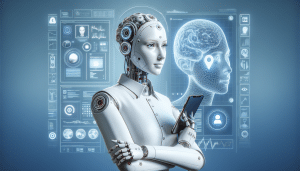AI in Healthcare Could Change Everything You Expect
Oliver Cooper September 28, 2025
Explore the fascinating rise of artificial intelligence in healthcare. Uncover how AI-driven diagnostics, predictive analytics, and innovation are transforming care, making it smarter and more responsive to real-world needs.
AI-Driven Diagnostics Are Redefining Medical Precision
Artificial intelligence now serves an essential role in medical diagnostics. Machine learning algorithms analyze complex imaging data with much greater speed and accuracy than basic human observation. For disorders like cancer, researchers are training models to detect subtle patterns in scans that may be invisible to the naked eye. This improves early disease detection and can offer new hope for outcomes, especially with conditions requiring rapid response. Algorithms constantly learn and adapt with every new dataset, which means diagnostic technology steadily evolves, making the system more dynamic and effective over time.
AI-based diagnostic tools provide a new level of support for doctors and specialists. With advanced image recognition capabilities, AI assists radiologists by flagging abnormal results or inconsistencies in X-rays, MRIs, and CT scans. This collaborative approach bridges the gap between human expertise and computational power. Many hospitals now use AI software as a second opinion, catching small details and minimizing the chance of error. Cases that once required time-consuming manual review can be processed swiftly, ultimately reducing waiting times for patients and streamlining the care process.
Integrating AI into diagnostic workflows can even support underserved regions or health systems with limited specialists. Telemedicine platforms enhanced by AI make specialist-level diagnostic guidance more widely accessible. Medical staff in remote or rural areas leverage cloud-based diagnostic models to confirm findings and consult with experts far away. This advances health equity. People can benefit from high-quality diagnostics regardless of their geographic location or access to major hospitals.
Predictive Analytics Could Revolutionize Patient Care
Predictive analytics powered by artificial intelligence is unlocking a new era of proactive healthcare. These AI models analyze hundreds of variables from electronic health records—such as lab results, medical history, and vital signs—to forecast a patient’s risk for specific conditions. Instead of reacting to illness after it appears, care teams can intervene earlier, reducing the chance of severe complications. This transition to predictive, individualized medicine signals a dramatic shift in the patient experience and the efficiency of healthcare delivery overall.
Chronic illnesses, like diabetes or heart disease, demand ongoing attention. Predictive analytics can spot early warning signals based on a patient’s behavioral trends and biometric data. AI tools notify both clinicians and patients about subtle changes that, without intervention, could become emergencies. These insights improve care coordination and help manage resources more effectively in crowded health networks. The result is better outcomes and fewer unexpected hospitalizations, a result that benefits individuals and the system at large.
Risk modeling excels when supported by large, high-quality datasets. As hospitals and research networks share more anonymized health data, AI models become more refined, learning population-level patterns and rare event markers. This contributes to public health, enabling targeted interventions and policy planning that are more precise. By harnessing AI’s predictive abilities, healthcare institutions can prepare for potential outbreaks, medication shortages, and the needs of vulnerable populations in a far more strategic way.
Automation and Robotics Strengthen Surgical Teams
Surgical robotics are transforming how operations are performed. AI algorithms navigate delicate procedures, helping surgeons achieve better accuracy with less invasive methods. Robotic arms—guided by real-time data and digital imaging—reduce the risk of human error and minimize tissue trauma. Surgeons have reported shorter recovery times and less post-operative pain in patients who undergo robotic-assisted procedures. These innovations let surgical teams focus their expertise where it matters most: critical decision-making and patient safety.
The collaborative potential between human surgeons and smart robotics extends across both routine and highly complex surgeries. Machine learning allows robotic systems to adapt fluidly to anatomical differences, responding to subtle changes during a procedure. This flexibility is crucial for handling unexpected challenges or complications mid-surgery. With AI-driven devices assisting, operations can often be performed with smaller incisions and greater consistency, reducing hospital stays and infection risks.
Beyond the operating room, automation powered by AI is optimizing logistics and routine hospital tasks. Medication distribution, room sterilization, and even supply chain management benefit from autonomous robots and intelligent scheduling systems. This operational support can free up human staff, allowing them to dedicate more energy to direct care. The overall impact is a healthcare setting that functions with greater speed, accuracy, and focus on patient needs.
Ethical Considerations and Data Privacy Remain Critical
As AI becomes more embedded in healthcare, ethics and privacy demand close attention. Sensitive data is at the center of most AI health applications. Ensuring the highest standards of cybersecurity is non-negotiable to maintain public trust. Measures must be taken to prevent data breaches and unauthorized usage. Many regulatory bodies are actively working to develop secure frameworks for clinical AI tools, continually updating protocols as new risks emerge.
Fairness and transparency are also crucial as AI guides high-stakes health decisions. Developers must minimize bias in training data and validate their models extensively before deployment. AI systems acting as ‘black boxes’—producing results without explainable reasons—raise ethical dilemmas. The push for explainable AI seeks to keep caregivers, regulators, and patients informed about how a given recommendation was made. This builds confidence in new technologies and supports responsible integration into clinical practice.
Public debate is already shaping the ethical future of health AI. Stakeholder engagement—including patients, families, and advocacy groups—is necessary to guide responsible innovation. Clear consent procedures and robust digital literacy initiatives can help communities understand how their data is used and what protections are in place. Balancing the promise of AI with deep respect for human rights is fundamental to the continued evolution of smart healthcare.
AI Unlocks Global Health Solutions and Breaks Barriers
Artificial intelligence is increasingly seen not just as a tool for individual patient care but also as a force for solving global health challenges. AI-powered systems enable remote consultation, diagnosis, and monitoring, offering lifelines to individuals in low-resource settings or areas affected by crises. Through scalable digital tools, public and private organizations can rapidly deploy medical expertise and supplies where they are most urgently needed. This flexibility is especially relevant during emergencies, pandemics, or natural disasters.
Language translation and medical knowledge databases enhanced by AI help bridge communication gaps that once delayed care. Automatic interpretation systems allow multilingual care teams to work more effectively with diverse patient populations. Additionally, global health organizations use AI for tracking disease outbreaks and managing vaccination campaigns, leading to faster mobilization and targeted action. AI does not just predict; it intervenes and informs at massive scale when circumstances demand swift response and resource coordination.
Partnerships between technology firms, research institutions, and NGOs highlight the shared ambition to use AI for the greater good. These coalitions fund open data projects, develop educational resources, and support capacity-building in lower-income countries. As digital infrastructure grows worldwide, AI’s effectiveness and reach only expand. This inspires hope that in the years ahead, healthcare innovation and access will continue to level up, addressing disparities and improving lives far beyond early AI adopters.
Preparing Healthcare Workers for the AI-Powered Era
With AI’s rapid integration, continuous learning is essential for all healthcare professionals. Upskilling programs are emerging to help staff navigate AI interfaces, interpret results, and utilize decision-support tools responsibly. Hospitals and educational institutions are blending digital literacy training with traditional medical education. This equips future practitioners to work alongside AI, blending technical acumen with human judgment.
Simulation-based learning platforms leverage AI to create real-world medical scenarios. These ‘smart’ simulators give doctors and nurses experience in using automated diagnostics, surgical robotics, and virtual consultations. Such interactive training promotes confidence and readiness, lessening anxiety about technology adoption. It also helps clarify where human expertise is irreplaceable—the nuances of empathy, creativity, and complex ethical reasoning remain vital even as AI becomes more capable.
Cross-discipline collaboration between computer scientists, engineers, and clinicians is becoming more common. Together, they shape tools that address frontline needs and reflect diverse perspectives. As AI matures, ongoing dialogue between health professionals and technology developers remains critical. This approach supports solutions that are practical, equitable, and trustworthy, ensuring healthcare’s digital transition truly benefits everyone.
References
1. Institute of Medicine. (National Academies of Sciences) (n.d.). Artificial Intelligence in Health Care: The Hope, the Hype, the Promise, the Peril. Retrieved from https://www.ncbi.nlm.nih.gov/books/NBK543516/
2. U.S. Food and Drug Administration. (n.d.). Artificial Intelligence and Machine Learning in Software as a Medical Device. Retrieved from https://www.fda.gov/medical-devices/software-medical-device-samd/artificial-intelligence-and-machine-learning-software-medical-device
3. World Health Organization. (n.d.). Ethics and governance of artificial intelligence for health. Retrieved from https://www.who.int/publications/i/item/9789240029200
4. National Institutes of Health. (n.d.). Artificial Intelligence: Opportunities and Considerations for the NIH. Retrieved from https://datascience.nih.gov/artificial-intelligence
5. Harvard Medical School. (n.d.). Medical Artificial Intelligence: Risk, Regulation, and Implementation. Retrieved from https://hms.harvard.edu/news/medical-artificial-intelligence-risk-regulation-implementation
6. Stanford University. (n.d.). Artificial Intelligence in Healthcare. Retrieved from https://aihealth.stanford.edu/research/







